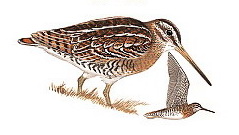|
| 질의: small white | 결과: 835번째/2236 | |
Solitary Snipe (Gallinago solitaria) - wiki
| 제목: | Solitary Snipe (Gallinago solitaria) - wiki
| |

| 해상도: 239x135
파일크기: 13831 Bytes
촬영일: 2007:08:27 09:52:00
등록시간: 2007:08:27 09:56:00
|
Solitary Snipe
From Wikipedia, the free encyclopedia
[Photo] Горный дупель Gallinago solitaria Hodgson, 1831. From: http://birds.krasu.ru/www/index.php?f=species&ids=160
The Solitary Snipe, Gallinago solitaria, is a small stocky wader. It breeds discontinuously in the mountains of eastern Asia, in eastern Russia, Kazakhstan Kyrgyzstan and Mongolia. Many birds are sedentary in the high mountains, or just move downhill in hard weather, but others are non-migratory, wintering in northeast Iran, Pakistan, northern India and Japan. It is a vagrant to Saudi Arabia, eastern India and Hong Kong.
Description
This is a large and heavy snipe 29-31 cm long with a stocky body and relatively short legs for a wader. Its upperparts, head and neck are streaked and patterned with medium brown stripes and whitish edges to the feathers forming lines down its back. The face is whitish. The breast is ginger-brown and the belly is white with brown barring on the flanks. The brown and black bill is long, straight and fairly slender. The legs and feet are yellowish-olive to yellowish-brown. All plumages are similar, but females average larger.
There are two quite similar subspecies. Nominate G. s. solitaria is very widespread. The breeding range of G. s. japonica, which is richer red and less white above, is unknown, but it winters in Japan.
The Solitary Snipe makes a hoarse kensh call as it takes off, and has a far carrying chok-a-chok-a call when displayinging.
The Solitary Snipe can be distinguished from other snipe by its ginger breast, whitish face and white lines on its back. It has a relatively slow, heavy flight.
Behaviour
This snipe breeds in mountain bogs and river valleys above the timberline,typically from 2,400 m to 5000 m. It is often found in similar marshes and swamps at lower altitudes when not breeding or on migration.
The Solitary Snipe builds a saucer-shaped nest of dry grass in the drier areas of its breeding wetland. The nest is concealed in a dense tuft of grass or sedges.
This bird has an aerial display, which involves flying high in circles, followed by a powerful stoop during which the bird makes a "drumming" sound, caused by vibations of modified outer tail feathers.
The Solitary Snipe forages by pushing its long bill deep into the mud seeking invertebrates, such as insects and worms, seeds and plants. It is quite approachable, but if alarmed, it crouches, and its cryptic plumage provides effective camouflage when the bird stands motionless amongst marsh vegetation. When flushed, it drops back into the marsh after a short slow flight.
http://en.wikipedia.org/wiki/Solitary_Snipe
| The text in this page is based on the copyrighted Wikipedia article shown in above URL. It is used under the GNU Free Documentation License. You may redistribute it, verbatim or modified, providing that you comply with the terms of the GFDL. |
|
댓글 |
|---|
| | 손님 |
|
Solitary Snipe (Gallinago solitaria)
French: Bécassine solitaire German: Einsiedlerbekassine Spanish: Agachadiza solitaria
Taxonomy: Gallinago solitaria Hodgson, 1831, Nepal.
Validity of races uncertain. Two subspecies normally recognized. |
^o^
동물그림창고 똑똑전화 누리집
^o^
|
|
|